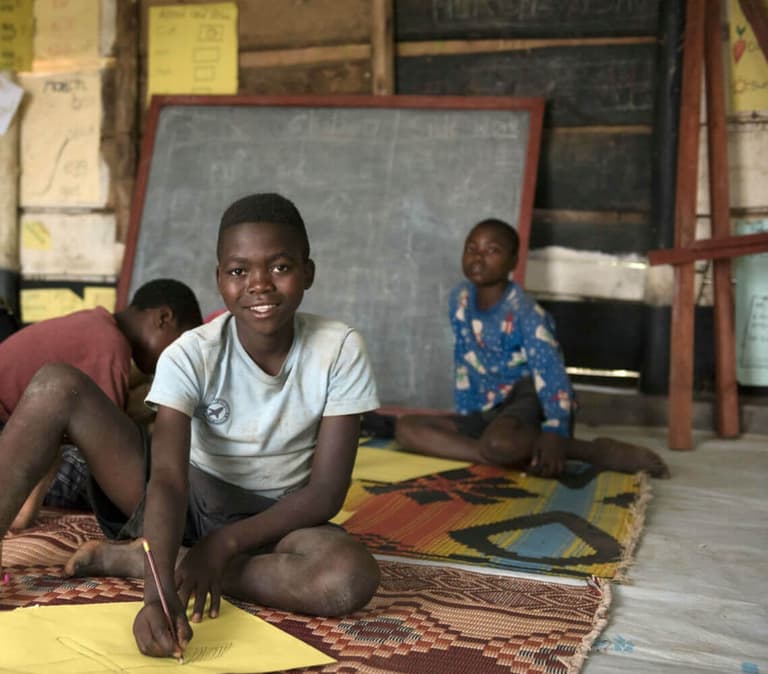Donate to Help Child Refugees
- Today, 426 million children live in conflict zones across the world.
- In Ukraine alone, a child has become a refugee almost every single second of the year-long war.
- Since our founding in 1919, Save the Children has worked tirelessly to provide refugees with life-saving assistance.

15.3 million people in Syria, including 7 million children, need of humanitarian aid

97% of the population in Syria live below the poverty line

Syria is the third least peaceful country in the world according to the Global Peace Index (GPI)
What is a refugee?
A refugee is a person who is seeking a safe haven after being forced to flee violence, persecution or war.
Refugees are defined and protected in international law. And seeking asylum is not a crime. While every refugee is initially an asylum seeker, not every asylum seeker will ultimately be recognized as a refugee.
Many refugees around the world live in vulnerable conditions, including refugee camps, informal settlements and on the streets. As the COVID-19 pandemic spread globally, many refugees were not in a position to social distance themselves or maintain basic hygiene, including simply washing their hands.
According to the UN Refugee Agency (UNHCR), the Ukraine war and other conflicts has pushed the number of people forced to flee conflict, violence and persecution to over 100 million for the first time in history — a record that "should never have been set." Among them are refugees, asylum seekers, and people displaced inside their own countries.
Why do people become refugees?
People become refugees for a number of different reasons; including:
- Persecution based on race, religion, nationality, membership of a particular social group or political opinion
- War
- Ethnic or political violence
For well over a decade, the number of people forced to flee their homes because of conflict and persecution has steadily increased. In 2012, these numbers spiked, resulting in what is now recognized as a global refugee crisis.
Several major crises around the world have contributed to the rising number of refugees, including:
- The on-going conflict in Syria, now in its 11th year.
- The conflict in Afghanistan—where most unaccompanied children in Europe are from—remains among the deadliest for children.
- South Sudan’s displacement crisis, which followed its independence.
- The rapidly escalating violence in Myanmar’s Rakhine State in 2017, which forced over half a million ethnic Rohingya to flee the country for their lives.
What are refugee camps and why are they created?
Refugee camps are temporary settlements created to provide refugees with immediate aid and protection.
Forced from home, refugees are often left with little to call their own. Lacking food, clean water, clothing and proper hygiene supplies, refugee children and their families are vulnerable to disease, abuse and worse.
There are refugee camps all over the world. Some of the largest refugee camps in the world include:
- Bangladesh
- Uganda
- Kenya
- Jordan
- Tanzania
- Ethiopia
What is the difference between a refugee, asylum seeker, migrant and immigrant?
Refugees, asylum seekers, migrants and immigrants are all terms used to describe people on the move, including children.
Refugees are people who are seeking a safe haven after being forced to flee violence, persecution or war.
Similar to a refugee, an asylum seeker is someone who may be in search of protection due to dangers in his or her home country. While every refugee is initially an asylum seeker, not every asylum seeker will ultimately be recognized as a refugee.
Traditionally, a migrant is considered a person who has left their home by choice and in search of a better opportunity. Because conflict or persecution did not force them from home, a migrant is not considered a refugee or asylum seeker.
A person who comes to a country with the intention of taking up permanent residence is called an immigrant.
How many child refugees are there in the world
Half of the global refugee population, nearly 13 million, are children below the age of 18.
Far too many refugee boys and girls are living in conditions not suitable for children, with limited access to education and healthcare, no freedom of movement, and almost entirely dependent on aid.
Before the COVID-19 pandemic, it was estimated that half of all refugee children in the world – 3.7 million – were out of school.
What do refugees do?
Refugees' lives have been thrown into a state of chaos because of what they experienced in their home countries prior to displacement, as well as on their journeys to find safety.
Like anyone, refugees need food, shelter and the opportunity to thrive. But after leaving everything behind and without livelihood opportunities to earn an income, many refugees struggle to survive.
With the generous support of our donors, Save the Children is able to provide refugee children and their families with essential items and relief.
Facts About Refugees Around the World
As the world is now witnessing the highest levels of displacement on record, here are some things to know about refugees.
- Half of the world's refugees are children.
- The UN has said that the Ukraine refugee crisis caused the fastest and largest displacement of people in Europe since World War II.
- In Syria alone, more than 6.8 million people have fled, seeking safety in Lebanon, Turkey, Jordan and beyond.
- More than 4 million Venezuelans are displaced abroad.
- Brutal conflict in South Sudan has forced more than 2 million South Sudanese refugees to flee in a desperate bid to reach safety.
- In Lebanon, where more than 1 million Syrian refugees reside, approximately 70% of Syrian refugees live below the poverty line.
- Over the past three years, more than 75,000 children have been born in the refugee camps of Cox’s Bazar.
- About 30% of refugees arriving through the Balkans are children, while roughly 25% of these children are unaccompanied.
- Nearly half of all refugee children are out of school, a figure likely worsened by the COVID pandemic.
- Less than 1% of all refugees are ever able to resettle and find a new life in safety and security.
Why Is Helping Refugees Important?
As, the global leader in child-focused humanitarian response, Save the Children helps more children in crisis recover and return to learning than any other global humanitarian organization.

Munguiko*, 14, takes part in activities at a Save the Children space in Rwamwanja refugee settlement in Uganda.
The COVID-19 pandemic has demonstrated that we are living in an extremely interconnected world and must focus on the fate of everyone around the world, especially our children.
Girls and refugee children stand to suffer the most from the harmful impacts of COVID-19. Rohingya refugee children in Cox’s Bazaar and children living in war-torn Syria already had difficulty accessing health services and continuing their studies prior to COVID-19.
Now, this unprecedented disruption to children's education and rising poverty caused by the COVID-19 pandemic could force at least 9.7 million children out of school forever, with girls, refugees, and internally displaced children most affected.
With 26 million men, women, and children now forced to flee their home countries due to conflict and persecution, it's more important than ever to take action to help improve the lives of refugees.
The United States has long been a leader in resettling refugees. We demonstrate our best as a nation, uphold our values, and lead by example when we welcome refugees.
* Name changed for protection
Other Ways to Help Refugees and Refugee Children
Donate
Support Save the Children’s mission. Donate to help children in the U.S. and around the world grow up healthy, educated and safe.
Gift Emergency Relief
Help ensure Save the Children can respond at a moment’s notice and deliver immediate, lifesaving aid during conflict, disasters and other crisis situations.



